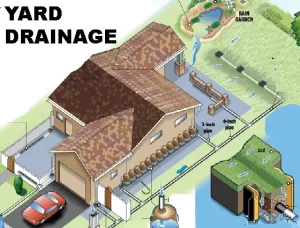
Making sure that your property is sloped to allow proper drainage can mean the difference between a trouble-free rainy season and a flooded basement a few times a year. Unwanted moisture intrusion—even at a level not serious enough to cause interior flooding—can create insidious problems that will be difficult to completely eliminate, such as weakened structural elements, mold growth, and other damage and health hazards.
Most problems with moisture in basements and crawlspaces are caused by poor site drainage. The ground should slope away from window wells, exterior basement stairs, and other means of egress. The bottom of each of these areas should be sloped to a drain. Each drain should have piping that connects it to a stormwater drainage system (if there is one) or that drains to either a discharge at a lower grade or into a sump pit that collects and discharges the water away from the building.
Rain: During the next heavy rainstorm without lightning, grab an umbrella and go outside. Walk around your house and look around at the roof and property. A rainstorm is a perfect time to see how the roof, downspouts, and grading are performing. Observe the drainage patterns of your entire property, as well as the property of your neighbor. The ground around your house should slope away from all sides. Downspouts, surface gutters, and drains should be directing water away from the foundation.
One important maintenance task is to monitor and maintain the drains and piping. Drains and piping should be open and clear of leaves, earth, and debris. A garden hose can be used to check water flow, although its discharge cannot approximate storm conditions.
House on a Hillside: Where a building is situated on a hillside, it is more difficult to slope the ground away from the building on all sides. On the high-ground side of the building, the slope of the ground toward the building could be interrupted by a surface drainage system that collects and disposes of rainwater runoff. Swales can be used to direct surface water away from the foundation. There are two general types of surface drainage systems: an open system, consisting of a swale (often referred to as a ditch), sometimes with a culvert at its end to collect and channel water away; and a closed system, consisting of gutters with catch basins.


